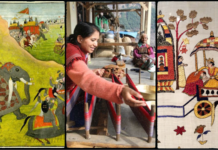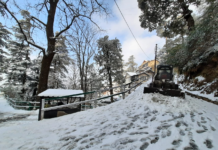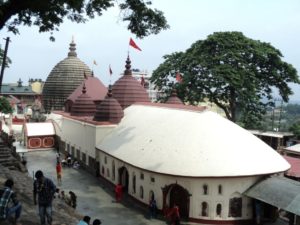
When the God of Rain smiles over the country and monsoon is around the corner, the Gateway of Northeast, Guwahati, opens its doors to pilgrims from across the country and beyond. Ambubachi Mela held in the famous Kamakhya temple situated on top of the Nilachal Hill of Guwahati is celebrated every year in June when the sun transits the zodiac of Mithuna. Kamakhya Mandir is a temple devoted to the Goddess Shakti, the divine feminine, and the primordial cosmic energy or Mother Earth herself. Legend has it that when Goddess Shakti died after her father insulted her husband, Lord Shiva, he was furious and carried her corpse around the world performing Tandava. It was Vishnu who split Shakti’s body into 52 parts called Shakti peeths to diminish Shiva’s fury. Every place where a peetha fell became a pilgrimage site including Kamakhya where the yoni of Shakti, that is the womb and genitalia of the Goddess, fell.
In this temple, unlike the other peethas, there is no idol for worship but a sculpted yoni. ‘Yoni’ means the source of origin that is the vulva of the Goddess and it is always moist due to a natural spring originating from the sculpture. During the festival of Ambubachi, the Goddess is said to be menstruating and the water of the spring turns red. The myth also says that the water of the Brahmaputra River flowing behind the temple also turns red with the menses of the Goddess. Unlike in the rest of Indian culture, the menses of Goddess Kamakhya is considered auspicious. Goddess Kamakhya or Shakti is considered as the embodiment of Mother Earth and when she menstruates the Earth cleanses of all impurities. Thus during this period, the sanctum is locked for three days and devotees abstain from cooking, reading holy books or plowing the field. These days are meant for her to rest where no one is supposed to demand but only serve her. On the fourth day, the doors are opened ceremoniously and a Mela is held in the premise. Thousands of devotees throng to the Goddess at her prime and receive the prasad.
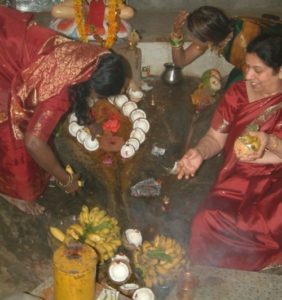
The Prasad offered in this fest is one of a kind as well. When the temple is closed during the period of Her menses, the yoni is covered in white clothes and flowers. At the end of the three days, the white cloth turns red that said to be soaked in Her menses. This wet cloth called Angabastra is given as Prasad to the devotees. It is supposed to be tied around the wrist or arm as a charm. The devotees touch the water that is called Angodak that literally translates to fluid from the body, to pay respect and circumambulate the temple to complete their pilgrim.
On the fourth day of the festival, animals and vegetables are sacrificed to please the Goddess. It has a story behind it as well. A demon called Narakasura wanted to marry the Devi but she insistently refused. After realizing that the demon will not relent to her wishes, she gave him a task to construct the stairway to the temple over a night. With the blessing of Lord Vishwakarma, the divine architect, Narakasura nearly completed the task and seeing this, the Goddess made a rooster crow before dawn. Thinking that it is dawn break, the demon and his masons stopped working immediately and the given time ended. When he realized that the Goddess tricked him he was raging and killed the rooster. This started the ritual of animal and vegetable sacrifice in the temple.
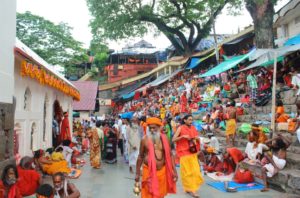
Ambubachi is also known as Ameti i.e. the Tantric fertility festival celebrated by the Tantric Shakti cult. Every year thousands of tantric sadhus from all across the country and the neighboring regions can be seen in the temple grounds. Shakti and Shaiva tantric cults are the closest to this celebration and can be identified by their red and black clothes. During the period of the Mela, people from all classes and sects are seen waiting to pay their respect to the Goddess at Her prime. From local families to long traveled pilgrims, from curious foreigners to trickster tantrics, everybody waits in harmony as the Goddess is said to rest. The crowd is well entertained as some Sadhus might decide to show some well learned tricks or the local women might break into a Naam, prayer songs praising the Lord.
During these four days, 5,000-10,000 sadhus reside in the premise and every day during the festival 10,000-15,000 pilgrims visit the temple. For this reason, Ambubachi M\ela is also known as ‘the Kumbh Mela of the East’.
It is often said that Ambubachi is the celebration of the Goddess’ menses but it has another meaning as well. ‘Ambubachi’ literally translates into “issuing forth of water”. As the festival is celebrated on the onset of monsoon, it marks the flooding of the river and its siltation. Prayers are made for the fertility of the Earth preparing it for procreation. Though, “Prithibi Rajashala Hoi” meaning ‘Mother earth is menstruating’ is a common chant you’ll most probably hear a lot. This year the Ambubachi Mela is scheduled to be held from 22nd June to 25th June 2018. So, come on and celebrate the femininity of the Mother Earth!







